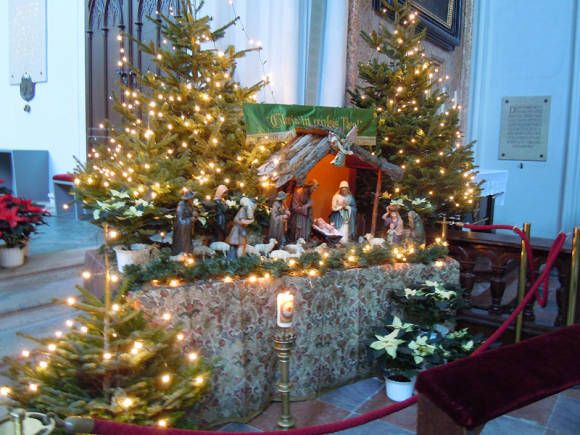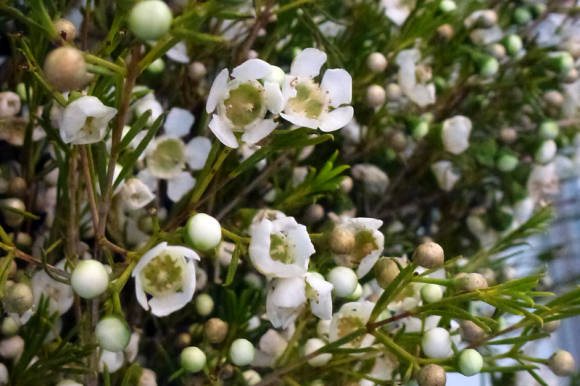With the most beautiful of the euphorbia - poinsettia (poinsettia), or Christmas star, we got acquainted relatively recently, when flowers from Holland began to arrive at our flower market. In the USA and Europe, it is traditionally a Christmas flower; it is widely used on the eve of the holiday to decorate temples, houses, and shopping centers. Due to its bright and unusual appearance on cloudy winter days, poinsettia quickly fell in love with Russians.

The most popular are the red-colored varieties, the combination of green and red is traditional for Christmas. But the variety of modern cultivars is truly enormous! It should be noted that the original species is not very decorative and does not look like modern varieties. Small, very bushy varieties with white (Cortez White, Freedom White), yellow, cream (Cortez Pink), pink (Cortez Pink), speckled (Jingle Bells), marble (Stargazer Marble), bent in the form of roses (Winterrose) and very large bracts.
 |  |
The scientific name of poinsettia is the most beautiful euphorbia (beautiful, beautiful, beautiful), the most beautiful euphorbia (Euphorbia pulcherrima) and she belongs to the genus of Euphorbia (Euphorbia) family of the same name (Euphorbiaceae). The name "euphorbia" comes from euphorbus, that was the name of the Greek physician of the king of Numidia and Mauritania Juba II (52-50 BC - 23 AD). Hinting at its large belly, the king gave this name to one of the plants. In 1753 Karl Linnaeus, the great taxonomist, appropriated this name Euphorbia to the whole family of Euphorbia. German botanist Karl Ludwig Wilenow, fascinated by the blooming poinsettia in his greenhouse, gave it a specific name pulcherrima, which means "fairest".
Poinsettia is native to the tropics, Mexico and Guatemala. In nature, it is a shrub or small tree from half a meter to 4 m in height. Leaves are dark green, toothed, up to 15 cm. Unattractive dioecious flowers are collected in dozens of apical numerous yellowish-green spherical inflorescences. The main decorative effect of the plant is given by the surrounding inflorescences of brightly colored bracts - bracts, which are often mistaken for a star-shaped flower. They serve to attract pollinating insects. The coloring of the bracts in bright colors is due to special photoreceptor proteins that respond to a decrease in daylight hours (in the homeland of poinsettia - in November-December). After flowering, a dormant period sets in, when euphorbia loses part of its leaves. Poinsettia contains milky juice, it does not cause fatal poisoning, but it can cause irritation on contact with the skin, temporary loss of vision if it gets into the eyes, and causes an eating disorder if eaten.

The Aztecs also considered it a symbol of purity and used it in their rituals.
The history of poinsettia as a Christmas plant is quite old. There is a beautiful legend, which originated in the 16th century, about a poor girl who had nothing to buy a present for Christmas. Inspired by an angel, she gathered the weeds along the road and took them to the church, where they turned into beautiful flowers.
In the 17th century, Spanish Franciscan monks who settled in southern Mexico cultivated this plant for its red color on Christmas Eve, its star-shaped leaves symbolized the Star of Bethlehem, while the flower was called Noche Buena, which means the night before Christmas, Christmas Eve.
The name "poinsettia" is associated with the name of Joel Roberts Poinsett, who was the first United States minister in Mexico from 1825 to 1829. A keen botanist, he imported poinsettia cuttings to the United States and shared them with his friends and gardeners he knew. In 1836, historian and gardener William Prescott proposed to rename the plant to poinsettia. (Poinsettia pulcherrima). Although Poinset was a distinguished congressman and ambassador, he will forever be remembered as the man who opened poinsettia to the United States.
In the 1920s, the Ecke family became interested in poinsettia, which was then growing freely in the wild in Southern California, and began to grow commercially, contributing in every way to the idea of making poinsettia a Christmas flower. Soon, in the 1960s, new varieties were created that could be grown as potted plants and the business from the fields moved under the roofs of greenhouses. The stage of sending plants and cuttings by air to different ends of the world has begun. By this time, poinsettia had already completely become an attribute of the celebration of Christmas. For a long time, until the 1990s, the Eck family managed to keep the technology of growing poinsettia a secret for sale, and they remained a monopolist in this market.
 |  |  |
Now the technology is no longer a secret and many gardeners around the world are growing this beautiful plant. The United States accounts for approximately 90% of poinsettia exports, is grown in all states and approximately 60 million plants are marketed annually. The flower is so popular in the United States that December 12 is considered Poinsettia Day in this country. Currently, about 100 commercial varieties are known, the selection is not only for beauty, but also for a longer preservation of the bracts, for the resistance of the plant during transportation.
Bright and cheerful poinsettias traditionally decorate Christmas in many countries, recently this custom has taken root in our country.
When choosing a plant you should pay attention to the inflorescences in the form of yellow balls, they should be still unopened. It is better not to purchase specimens with open or fallen inflorescences.
Post-purchase containment conditions

When buying a plant, it is imperative to protect it from the cold, carefully pack it during transportation, this is a tropical plant and does not tolerate even short-term cooling.
At home, it is necessary to provide the plant with the following conditions:
- sunny place with protection from the midday sun.
- warm content, optimum temperature +18 ... + 22оС. At temperatures below + 13 ° C and above + 27 ° C, poinsettia can shed its leaves. Avoid exposing the plant to any cold. Make sure the leaves do not touch the cold glass.
- high air humidity, it is advisable to often spray the air around the plant, contact with the leaves will cause stains.
- moderate regular watering, after the topsoil has dried. It is advisable to keep the substrate always slightly moist. When watering, a clod of earth must be completely wetted; excess water from the pan must be drained. Watering only with warm and preferably soft water. Cold water can cause leaf fall. Drying out of the substrate will cause wilting of the leaves, and leaf fall is also possible.
- protect from any drafts - poinsettia does not tolerate both hot dry air from batteries and cold drafts, they lead to the shedding of leaves.
- the plant does not need feeding at this stage.
- do not transplant.
The poinsettia is grown as a Christmas bouquet and is usually thrown away after flowering. But, like many tropical plants, subject to certain rules in care, you can grow it as a perennial shrub with regular winter flowering.
Leaving after the holidays
January to February-March normal care, regular watering, the soil is always kept slightly moist, the temperature is about + 20 ° C, frequent spraying around the plant is desirable to maintain air humidity.

March-April watering is reduced, the soil is allowed to dry out between waterings, but the plant should not be wrinkled. Spraying is canceled. Reduce the temperature to + 15 ° C. During this time, poinsettia usually loses some of its leaves. The rest period lasts approximately 4 weeks.
April-May the plant is returned to a warm and sunny room, the poinsettia needs at least 4 hours of sun every day, preferably in the morning.When poinsettia is grown for sale, it is sometimes specially infected with microorganisms of a certain type, which cause additional branching to create a multiplicity of inflorescences. At home, the plant tends to grow upwards, loses its decorative effect. To give compactness and for abundant flowering, the shoots are cut, leaving about 5-10 cm above the pot, this stimulates branching and, as a result, abundant subsequent flowering.
Transplanted by transferring to a larger pot with the addition of fresh soil (2 parts of peat, 1 part of sod land, 1 part of sand or perlite). It is advisable to add long-term fertilizers to the soil. Watering is gradually increased, spraying around the plant is resumed. With the advent of new growth, they begin to feed the plant every two weeks, unless long-acting fertilizers have been added.
June-July-August, after the threat of night frosts disappears, the plant can be taken out on a sunny balcony with protection from the midday sun, the soil should be kept evenly slightly moist, fed regularly, every 2 weeks. During this time, the shoots should be slightly shortened two more times to form a denser crown. The last pruning should be before mid-August, later the poinsettia begins to form flower buds.
In September you should not expose the plant to temperatures below + 18 ° C; if there is a threat of cold snap, it is better to bring the poinsettia home from the balcony. At this time, watering and feeding continue, as in previous months. Spraying is resumed when the central heating batteries are turned on.
How to make poinsettia bloom again

October-November the plant begins to limit daylight hours. From the first days of October at 12-14 o'clock (from 6-8 o'clock in the evening and until 8 o'clock in the morning) the poinsettia is hidden from the light in a dark cabinet, under a dark bag or light-tight box. Without additional hours of darkness, flower buds will not develop and the leaves will remain green. Even a small amount of light from a light bulb can disrupt the coloration of the bracts. Reduced daylight conditions must be observed for at least 10 weeks. During the daytime, however, it is necessary to provide the plant with bright sunlight, watering and feeding continues as before.
December, when flower buds are visible and the upper leaves begin to change color, stop darkening the plant. From about mid-December, feeding is stopped. Re-blooming is usually not as abundant or as bright as when purchased. Further care as for just purchased poinsettia.
Multiply poinsettia by cuttings. To do this, take summer shoots 5-7 cm long, which remain after pruning the plant. Be sure to let the milky juice drain. To do this, the handle is kept under running cool water. Then they are planted in sterile, slightly moist sand, preferably with the use of root formers (Kornevin, Heteroauxin). Cuttings, like adult plants, should not be exposed to temperatures below + 150C. By autumn, the rooted plants can be transferred into small pots, they will reach their magnificence only after a year.
Pests. Damaged by mealybugs, spider mites, thrips.
Read more about pest control measures in the article Houseplant pests and control measures.
This not so whimsical plant will perfectly decorate the New Year and Christmas holidays, bring joy and good mood to the house!









